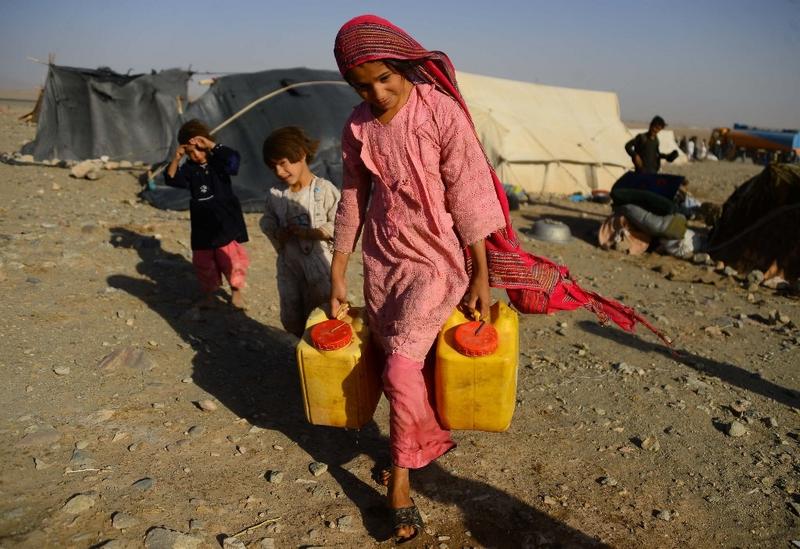 In this photo taken on Aug 3, 2018, a drought-displaced Afghan girl carries water containers filled from a tanker at a camp for internally displaced people in Injil district of Herat province. (PHOTO / AFP)
In this photo taken on Aug 3, 2018, a drought-displaced Afghan girl carries water containers filled from a tanker at a camp for internally displaced people in Injil district of Herat province. (PHOTO / AFP)
SINGAPORE- Millions of Afghans are struggling to put food on the table as prolonged drought disrupts supplies in a country reeling from a surge in violence as US-led foreign troops complete their withdrawal.
Aid organizations are calling on donors for urgent funds and humanitarian assistance with the annual wheat harvest expected to plummet by nearly half and millions of livestock at risk of death as water supplies run dry.
"It's a multiple shock," said Necephor Mghendi, head of the International Federation of Red Cross and Red Crescent Societies (IFRC) in Afghanistan.
"Generally, there has been an impact on availability and distribution of food ... and the conflict is causing internal displacement, which means increased demand for resources in certain regions."
Aid organizations are calling on donors for urgent funds and humanitarian assistance with the annual wheat harvest expected to plummet by nearly half and millions of livestock at risk of death as water supplies run dry
ALSO READ: US to evacuate Afghans who supported its military in late July
The entire country is facing moderate to severe drought, President Ashraf Ghani said in late June, acknowledging that the national disaster management budget was not enough to cover what experts say is one of the worst droughts in decades in terms of geographic scale.
"We ... will not allow the country to face famine," Ghani said in a statement. "Our effort is to address all districts, even those under the Taliban control."
The Islamist insurgents have stepped up their campaign to defeat Ghani's U.S.-backed government as foreign forces leave after 20 years of conflict and have swept into numerous rural districts across the country.
With very little functioning irrigation, Afghanistan relies on snow melting in its mountains to keep its rivers flowing and fields watered during the summer and snowfall last winter was again very low.
Fahad Saeed, a climate scientist at Climate Analytics, said a La Niña phenomenon and a weakening jet stream moving weather systems more slowly across the planet could be factors behind Afghanistan's extremely dry weather.
While it is difficult to link individual events to climate change, scientists agree that global warming driven by greenhouse gas emissions is contributing to extreme weather around the world.
"Afghanistan is a good example of climate injustice. It has historically no role in the climate change mess but they are bearing the brunt of it," Saeed said.
READ MORE: US offers refugee status to more Afghans facing danger
Afghanistan was one of 23 countries the United Nations identified as "hunger hotspots" in a report last month, with at least 12 million people out of a population estimated at 36 million facing a food security crisis of not knowing when or where their next meal will come from.
The IFRC is trying to raise US$16.5 million but has managed less than half of that, Mghendi said.
"It's a dire humanitarian situation that requires as much support as possible to get the very basics," Mghendi said.
"Every dollar will help somebody."


